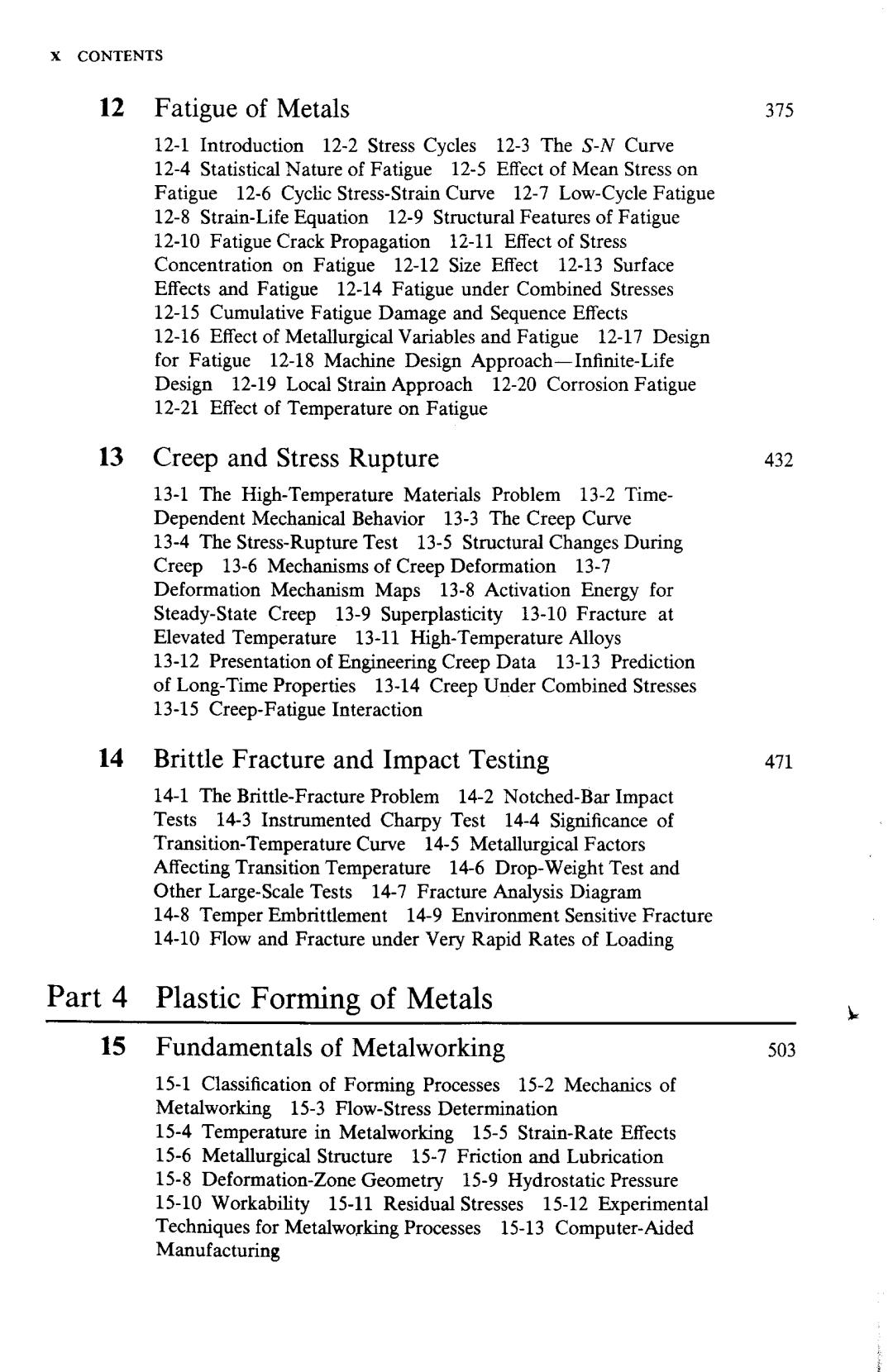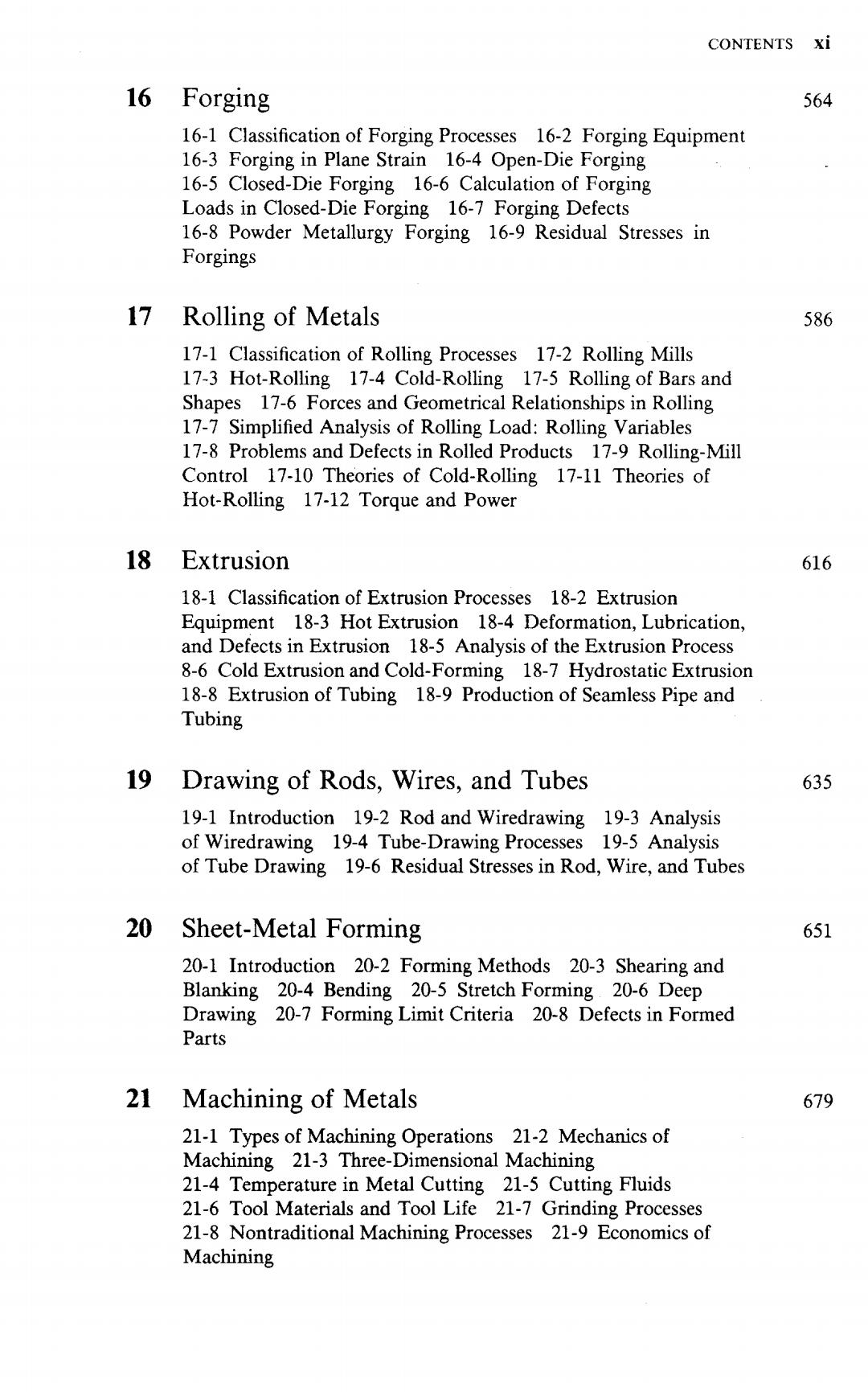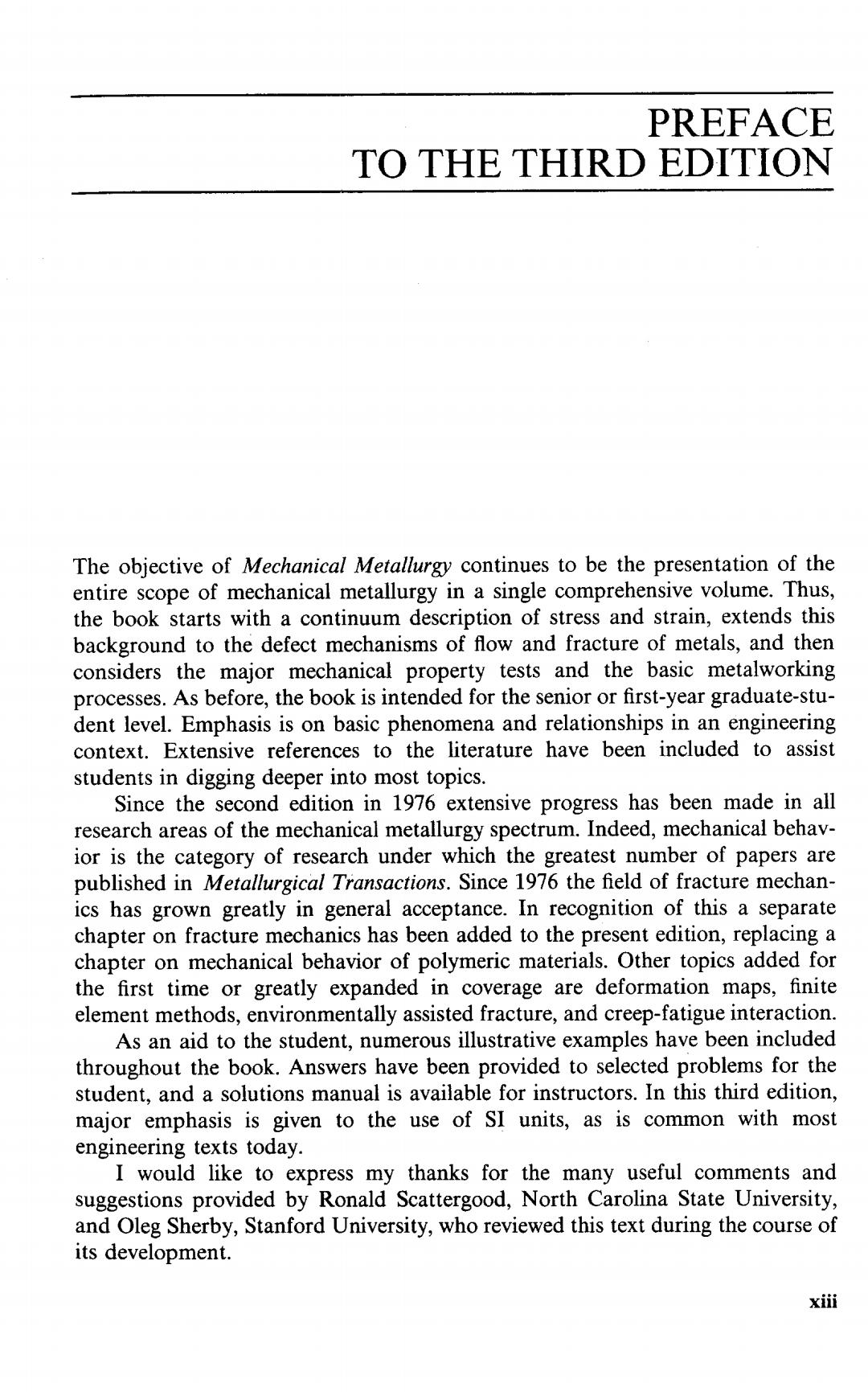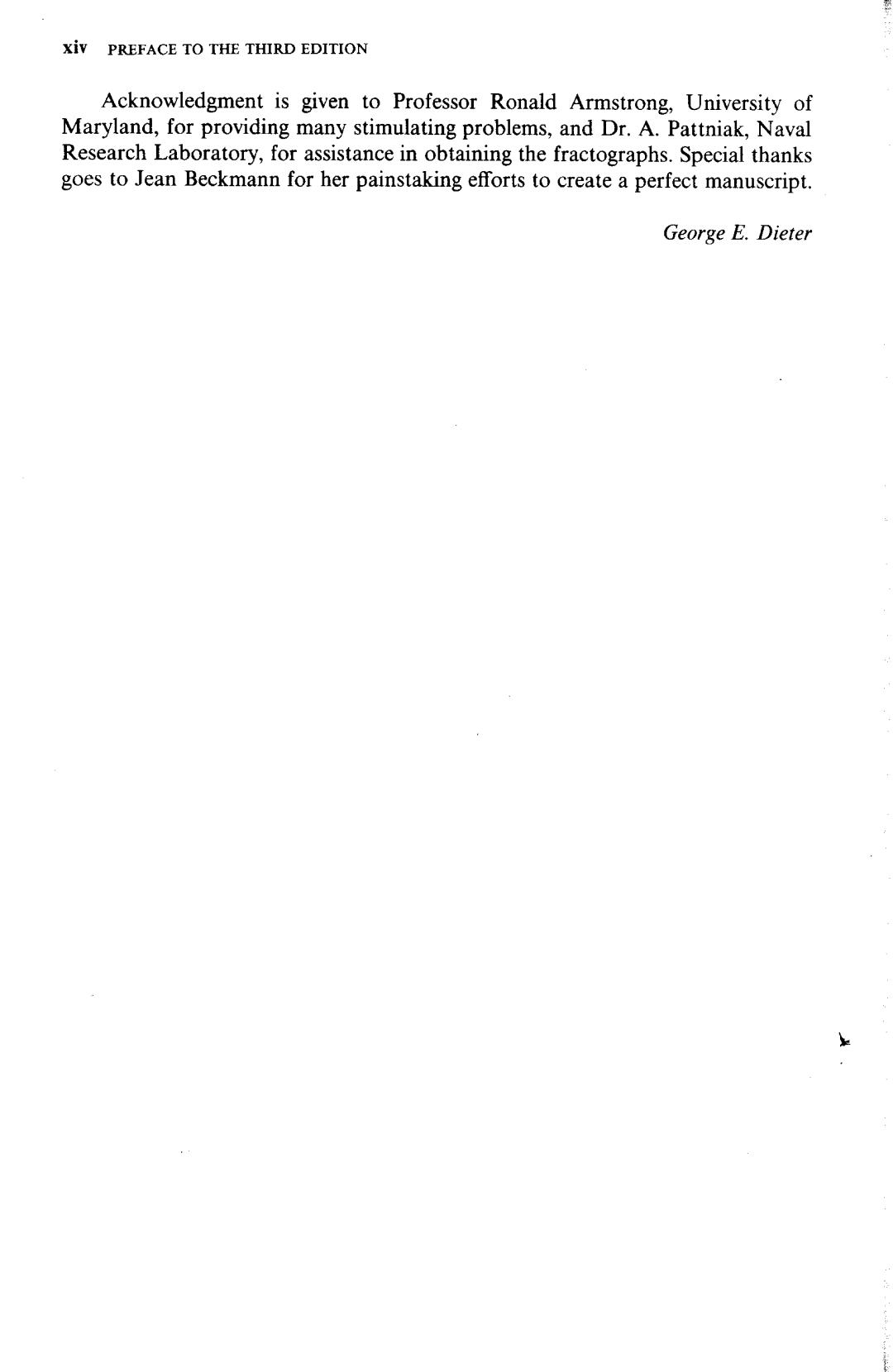
X CONTENTS 12 Fatigue of Metals 375 12-1 Introduction 12-2 Stress Cycles 12-3 The S-N Curve 12-4 Statistical Nature of Fatigue 12-5 Effect of Mean Stress on Fatigue 12-6 Cyclic Stress-Strain Curve 12-7 Low-Cycle Fatigue 12-8 Strain-Life Equation 12-9 Structural Features of Fatigue 12-10 Fatigue Crack Propagation 12-11 Effect of Stress Concentration on Fatigue 12-12 Size Effect 12-13 Surface Effects and Fatigue 12-14 Fatigue under Combined Stresses 12-15 Cumulative Fatigue Damage and Sequence Effects 12-16 Effect of Metallurgical Variables and Fatigue 12-17 Design for Fatigue 12-18 Machine Design Approach-Infinite-Life Design 12-19 Local Strain Approach 12-20 Corrosion Fatigue 12-21 Effect of Temperature on Fatigue 13 Creep and Stress Rupture 432 13-1 The High-Temperature Materials Problem 13-2 Time- Dependent Mechanical Behavior 13-3 The Creep Curve 13-4 The Stress-Rupture Test 13-5 Structural Changes During Creep 13-6 Mechanisms of Creep Deformation 13-7 Deformation Mechanism Maps 13-8 Activation Energy for Steady-State Creep 13-9 Superplasticity 13-10 Fracture at Elevated Temperature 13-11 High-Temperature Alloys 13-12 Presentation of Engineering Creep Data 13-13 Prediction of Long-Time Properties 13-14 Creep Under Combined Stresses 13-15 Creep-Fatigue Interaction 14 Brittle Fracture and Impact Testing 471 14-1 The Brittle-Fracture Problem 14-2 Notched-Bar Impact Tests 14-3 Instrumented Charpy Test 14-4 Significance of Transition-Temperature Curve 14-5 Metallurgical Factors Affecting Transition Temperature 14-6 Drop-Weight Test and Other Large-Scale Tests 14-7 Fracture Analysis Diagram 14-8 Temper Embrittlement 14-9 Environment Sensitive Fracture 14-10 Flow and Fracture under Very Rapid Rates of Loading Part 4 Plastic Forming of Metals 15 Fundamentals of Metalworking 503 15-1 Classification of Forming Processes 15-2 Mechanics of Metalworking 15-3 Flow-Stress Determination 15-4 Temperature in Metalworking 15-5 Strain-Rate Effects 15-6 Metallurgical Structure 15-7 Friction and Lubrication 15-8 Deformation-Zone Geometry 15-9 Hydrostatic Pressure 15-10 Workability 15-11 Residual Stresses 15-12 Experimental Techniques for Metalworking Processes 15-13 Computer-Aided Manufacturing

CONTENTS xi 16 Forging 564 16-1 Classification of Forging Processes 16-2 Forging Equipment 16-3 Forging in Plane Strain 16-4 Open-Die Forging 16-5 Closed-Die Forging 16-6 Calculation of Forging Loads in Closed-Die Forging 16-7 Forging Defects 16-8 Powder Metallurgy Forging 16-9 Residual Stresses in Forgings 17 Rolling of Metals 586 17-1 Classification of Rolling Processes 17-2 Rolling Mills 17-3 Hot-Rolling 17-4 Cold-Rolling 17-5 Rolling of Bars and Shapes 17-6 Forces and Geometrical Relationships in Rolling 17-7 Simplified Analysis of Rolling Load:Rolling Variables 17-8 Problems and Defects in Rolled Products 17-9 Rolling-Mill Control 17-10 Theories of Cold-Rolling 17-11 Theories of Hot-Rolling 17-12 Torque and Power 18 Extrusion 616 18-1 Classification of Extrusion Processes 18-2 Extrusion Equipment 18-3 Hot Extrusion 18-4 Deformation,Lubrication, and Defects in Extrusion 18-5 Analysis of the Extrusion Process 8-6 Cold Extrusion and Cold-Forming 18-7 Hydrostatic Extrusion 18-8 Extrusion of Tubing 18-9 Production of Seamless Pipe and Tubing 19 Drawing of Rods,Wires,and Tubes 635 19-1 Introduction 19-2 Rod and Wiredrawing 19-3 Analysis of Wiredrawing 19-4 Tube-Drawing Processes 19-5 Analysis of Tube Drawing 19-6 Residual Stresses in Rod,Wire,and Tubes 20 Sheet-Metal Forming 651 20-1 Introduction 20-2 Forming Methods 20-3 Shearing and Blanking 20-4 Bending 20-5 Stretch Forming 20-6 Deep Drawing 20-7 Forming Limit Criteria 20-8 Defects in Formed Parts 21 Machining of Metals 679 21-1 Types of Machining Operations 21-2 Mechanics of Machining 21-3 Three-Dimensional Machining 21-4 Temperature in Metal Cutting 21-5 Cutting Fluids 21-6 Tool Materials and Tool Life 21-7 Grinding Processes 21-8 Nontraditional Machining Processes 21-9 Economics of Machining

xii CONTENTS Appendixes 合 The International System of Units (SD) 709 Problems 712 Answers to Selected Problems 734 Indexes 739 Name Index Subject Index

PREFACE TO THE THIRD EDITION The objective of Mechanical Metallurgy continues to be the presentation of the entire scope of mechanical metallurgy in a single comprehensive volume.Thus, the book starts with a continuum description of stress and strain,extends this background to the defect mechanisms of flow and fracture of metals,and then considers the major mechanical property tests and the basic metalworking processes.As before,the book is intended for the senior or first-year graduate-stu- dent level.Emphasis is on basic phenomena and relationships in an engineering context.Extensive references to the literature have been included to assist students in digging deeper into most topics. Since the second edition in 1976 extensive progress has been made in all research areas of the mechanical metallurgy spectrum.Indeed,mechanical behav- ior is the category of research under which the greatest number of papers are published in Metallurgical Transactions.Since 1976 the field of fracture mechan- ics has grown greatly in general acceptance.In recognition of this a separate chapter on fracture mechanics has been added to the present edition,replacing a chapter on mechanical behavior of polymeric materials.Other topics added for the first time or greatly expanded in coverage are deformation maps,finite element methods,environmentally assisted fracture,and creep-fatigue interaction. As an aid to the student,numerous illustrative examples have been included throughout the book.Answers have been provided to selected problems for the student,and a solutions manual is available for instructors.In this third edition, major emphasis is given to the use of SI units,as is common with most engineering texts today. I would like to express my thanks for the many useful comments and suggestions provided by Ronald Scattergood,North Carolina State University, and Oleg Sherby,Stanford University,who reviewed this text during the course of its development. xiii

Xiv PREFACE TO THE THIRD EDITION Acknowledgment is given to Professor Ronald Armstrong,University of Maryland,for providing many stimulating problems,and Dr.A.Pattniak,Naval Research Laboratory,for assistance in obtaining the fractographs.Special thanks goes to Jean Beckmann for her painstaking efforts to create a perfect manuscript. George E.Dieter